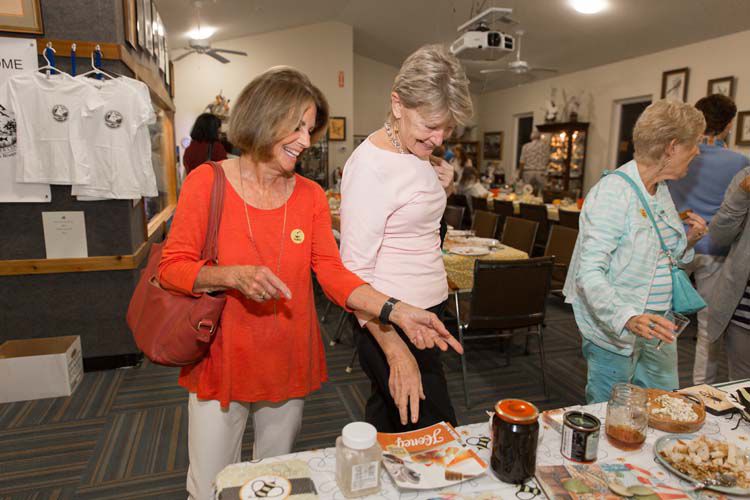
In our fundraiser-rich community it can be challenging for an event planner to come up with a fresh idea, but Pelican Island Audubon Society board member Donna Halleran was up to the challenge, drawing several dozen curious supporters to the Audubon House last Friday for an inaugural Taste of Honey from Around the World event.
From honeyed wines at a tasting table manned by Audubon President Dick Baker, to Halleran’s beeswax soaps displayed as perfect-for-holiday gifts, the unique evening was buzzing with all things bee, including cupcakes topped with smiley plastic bees, beehive-shaped cakes and jars of honey. Even sweeter, the honey tasting was as interesting and informative as a formal wine tasting, without the need for a designated driver.
Two rows of long cafeteria tables placed down the center of the large main room had been dressed with black and yellow bee-pattern tablecloths and candles made of (wait for it) beeswax. Places were precisely set for the honey tasting, with bee-pattern plates and napkins, two raspberries, a slice of pear, three different cheese cubes, a slice of cranberry bread and a ginger cookie, alongside six small cups of honey ranging in shades from water clear to deep amber to creamy white. Tasters used bee-pattern pens to record their descriptions and observations of the various selections.
Very much like assessing wines, the tasters considered color, aroma, initial impression, predominant flavors and its terroir; the characteristic taste and flavor imparted by the environment in which it is produced. Honey tastes vary depending upon where the bees collect their pollen, and the samples here came from such diverse climes as Canada and Tasmania and Indian River County.
Halleran and her husband have been beekeepers and honey aficionados for years, even planning vacation according to “where the bee hives are.” She led her novice honey tasters on a fascinating journey through Bee 101, punctuated with humor, anecdotes and a hive-full of great information, including fun facts such as that bees make honey by regurgitating the nectar.
Halleran explained that bees survive in cold weather by snuggling into a very tight bee-ball inside the hive; the center of which gets to about 90 degrees. When the bees on the outside layer get too cold, the others switch places to keep everyone warm. Who knew? And, whatever you do, don’t put honey in the microwave! The crystals that form are absolutely OK.
Audubon Society member Jean McGovern called the event “very informative,” and especially enjoyed trying honey from different parts of the world. Emily McDonough agreed, and shared that the bee people she called when a rogue swarm refused to vacate the back of her summer kitchen, were very gentle and knowledgeable in dealing with the little insects.
Craig Holtermann was especially interested, having been a beekeeper and a fireman in Staten Island, where he kept his bees at the fire station. No surprise, his firefighter buddies called him Buzzfire.
All were hopeful that the Pelican Island Audubon Society will bring the fun, informative and yummy event back next season.



